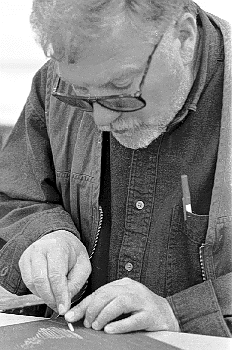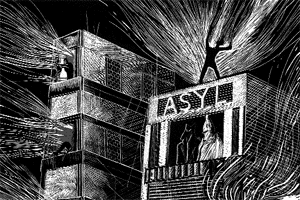SPRING 1998
Volume 15, Number 3

WITNESS TO HISTORY
PRINTMAKER JIM TODD
by Constance Poten
When the Berlin Wall fell on November 9, 1989, the whole world felt the shock of liberation. Nearly a year later, German reunification brought catastrophic change that, with all its joy and terror and sudden, disorienting freedom, awakened East Germans to a strange, ruined place. In 1991, printmaker and University of Montana art Professor Jim Todd went to Leipzig, Germany, to record his impressions of the historic German transformation. Over the next four years he produced woodcuts and prints that express the horrors of survival in desperate times and expose the cruel potential beneath the skin of us all.
 |
| Todd’s prints and woodcuts have been exhibited in museums in China, England, Germany and Russia. He is a member of the British Society of Wood Engravers and a full fellow in the Royal Society of Painter-Printmakers. |
Shoplifting was rampant. Suspected of shoplifting himself, Todd was searched at a grocery market. He demanded to see the manager. “He was more tired than angry,” says Todd. “He wearily explained that half the shoplifters are foreigners.”
The upheaval was a breeding ground for anger and fear in the form of skinheads, thieves, racists and mobsters. To Todd, it echoed Germany in the frightening years between the world wars, when the Weimar Republic gave way to the Nazi regime. His prints recall the sinister Expressionist art of German painter George Grosz of the 1920s.
“The realities,” Todd says, “are a lot more complicated and distressing than [Americans] expect. Neo-Nazism is on the rise; East Germany didn’t educate people about the horrors of fascism.” Because of the extreme unemployment, Todd says the “protesters are violent in their disappointment with reunification.”
Carving Chaos
The electric current of the times compelled Todd. Exhibitions of his work in Germany culminated in an impressive catalog, Images from Leipzig, 1991-92. The catalog is divided in three sections: writings by Todd, Rendsburg cultural affairs director Heinz Thieme and Leipzig art historian Renate Böning; portraits of printmakers who have influenced Todd’s work, including Dürer, Daumier and Picasso; and selected Leipzig woodcuts.
 |
| In this detail from The Burning of the Rostock Asyl, Coyote and a Klansman observe events from above. |
Woodcuts are the perfect medium for Todd’s subject: Their raw immediacy throws forth the looming dangers and absurdist humor, the lonely chaos and industrial filth of a world that has lost its center. Black, white and red slash the scenes cutting a perilous reality like glass shards. In several pieces, Todd invokes the image of Coyote, the legendary Native American trickster, as a “bemused spectator of dangerous historical times.” Dressed in a black suit, Coyote is slyly enjoying the savagery of riots and fires. Smoke belches from stacks throughout the city.
“They used cheap gas and brown coal for heat,” Todd says. “The air was very hard on me.” He couldn’t sleep it was so difficult to breathe; the print “Insomnia” depicts his fearful images in waking dreams. Todd retreated to the city zoo to breathe better air. He found the zoo a cosmos of Leipzig. In his woodcut, “Leipzig Zoo,” a banner proclaims “McDonald’s is Finally Here!” over the zoo animals neurotically pacing, caged in decrepit buildings.
Another woodcut, “The Turning Point,” portrays Renate Böning’s description of the events of October 9, 1989. One month to the day before the Berlin Wall came tumbling down thousands of people came out of hiding to demonstrate for civil rights, not knowing whether or not they would be slaughtered. They knew that disguised soldiers infiltrated the demonstration, moving among the people who prayed in fear and hope. They knew the soldiers could choreograph a massacre. Böning wrote:
It was Nadja my friend’s daughter who noticed the rubber truncheon in the pant leg of the supposed-to-be punker. She then did something unheard of, and pointed...and shouted ‘Look at that!’ Everybody looked, screamed and pointed. The ‘punker’ remained silent. Then I knew that something had truly changed.
Witnessing Social Change
 |
| "Leipzig Zoo." The zoo, like Leipzig, had been allowed to decay. |
It appears predestined that Todd would be the person to witness and depict the aftermath of the collapse of Erich Honecker’s German Democratic Republic. A Great Falls native, Todd was in Germany in the 1960s, as a medic in the U.S. Army, when the Berlin Wall went up. He married a German, Julia, bonding his fate to Germany with family. In 1984 he lived near the wall, researching the social history of twentieth-century German art.
When the wall came down five years later, Todd visited Leipzig, where he had worked for a prestigious Leipzig arts encyclopedia that was taken over by the West. “I finally met people I’d worked with for five years,” he recalls. “People were frightened and excited. The transition was very unstable.” On his office door in the art department - where he has taught for twenty-eight years - is the East German bank statement from the day the wall fell, stamped “account closed.”
The German Academic Exchange and UM sponsored Todd’s sabbatical in 1991-92. “The West German government gave me a grant to write a manuscript on the East German Seemann Publishing House,” Todd says. “It was very interesting. I interviewed Communist editors and historians after the fall.”
Todd’s passions for social change and art also have taken him to China and Russia before such exchanges became commonplace. In both places he witnessed the paranoia and hardship citizens endured. One arresting scene was a woman begging in Moscow’s Metro under a Social Realist painting of Lenin. “She was blessing herself,” says Todd. “The new authority is the church. Priests have replaced commissars.”
Todd says he feels privileged for the chance to witness close up the harrowing transitions in the Communist world. In these complex times, he shows us just how tenuous civilization really is. M
Writer Constance Poten is also owner of the Côtes du Crotale vineyard.